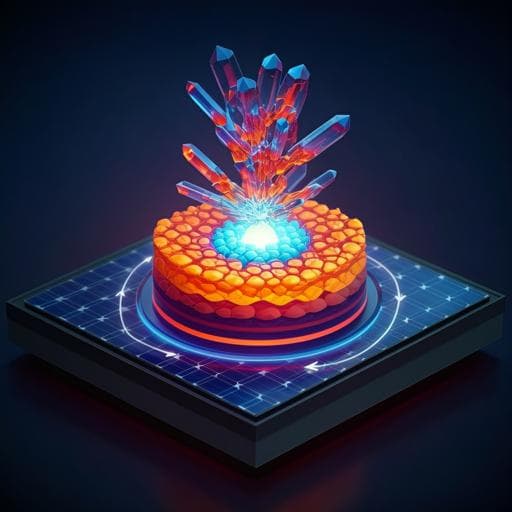
Chemistry
Sustainable thermal regulation improves stability and efficiency in all-perovskite tandem solar cells
S. Tan, C. Li, et al.
Discover groundbreaking advancements in mixed Sn-Pb perovskites, enhancing their stability and efficiency for photovoltaic applications! This innovative research, conducted by Shuchen Tan and colleagues, employs a novel thermal regulation strategy using *ortho*-carborane, significantly increasing heat transfer and prolonging cell efficiency. Experience enhanced thermal stability and impressive performance in all-perovskite tandems.
~3 min • Beginner • English
Introduction
Perovskite solar cells (PSCs) have rapidly approached silicon’s efficiency at lower cost, but mixed tin–lead (Sn–Pb) perovskites, which provide an ideal low bandgap (~1.25 eV) for single-junction and all-perovskite tandem architectures, still face challenges in efficiency and especially stability. Heat generation in solar cells from non-radiative recombination, thermal relaxation, and reverse-bias (Joule) heating is particularly detrimental in perovskites due to their low thermal conductivity, causing heat accumulation and hotspots that accelerate thermal degradation. Mixed Sn–Pb perovskites also suffer from facile Sn2+ oxidation and associated defect formation, further exacerbating recombination-driven heating. This work investigates whether improving heat transfer within the absorber can suppress thermal accumulation and thereby enhance operational and thermal stability while maintaining or improving efficiency. The authors propose introducing electron-delocalized carborane molecules—specifically ortho-carborane (o-CB)—into the perovskite to increase thermal transport, regulate crystallization, and improve interfacial energetics in mixed Sn–Pb PSCs and all-perovskite tandems.
Literature Review
Thermal management is recognized as essential in electronics and silicon photovoltaics, yet has been underexplored in mixed Sn–Pb PSCs and tandems. Prior work highlights: (1) the strong temperature and reverse-bias vulnerabilities of PSCs relative to conventional PV; (2) lower thermal conductivity in hybrid perovskites compared to Si leading to hotspot formation and faster degradation; (3) instability pathways in Sn–Pb alloys due to Sn2+ oxidation, which increases defect density and non-radiative recombination (heat). Thermal management approaches in PV and perovskites include high thermal conductivity backsheet strategies and additive engineering; however, tailored solutions for mixed Sn–Pb absorbers in p–i–n devices and tandems remain limited. Carboranes, featuring electron delocalization, have been reported to exhibit high heat transfer capability and good chemical stability, motivating their use here as heat-transfer additives compatible with perovskite processing.
Methodology
- Materials/additive: Aromatic ortho-carborane (o-CB, C2B10H12) selected for low thermal hysteresis and stability. o-CB was dissolved directly into mixed Sn–Pb perovskite precursor solutions at varying concentrations (0, 1, 2 mg mL−1; 1 mg mL−1 optimal). Distribution through the perovskite film was profiled (decreasing from buried interface to top surface).
- Film and device architectures: p–i–n devices with ITO/PEDOT:PSS/perovskite/C60/SnO2/Ag. For tandems, monolithic 2T all-perovskite with WBG top (Me-4PACz HTL) and o-CB-treated NBG Sn–Pb bottom subcell; interlayers included ALD SnO2 and Au/PEDOT:PSS recombination contact.
- Thermal characterization: Through-plane thermal conductivity measured by hot-disk technique (DRL-III) at 25, 55, 85 °C. IR thermal imaging (FLIR T640) to monitor cooling/heating dynamics and spatial temperature distribution under 1-sun illumination. T-type thermocouples (YET-610) monitored layer-wise temperatures during illumination. Device thermal resistance and transmissivity were assessed (Supplementary Table 2). Specific heat capacity of o-CB was evaluated as a function of temperature. Ansys Icepak simulations modeled heat absorption and dissipation for films with/without o-CB under defined geometry and boundary conditions.
- Structural and morphological stability: XRD (Cu Kα) after thermal treatments (25, 100, 150 °C) to monitor PbI2 formation; SEM (top-view, cross-section, buried interface after peel-off) after heating at 85 °C for 200 h to visualize decomposition and microstructure.
- Optoelectronic characterization: UV–Vis absorption; PL and TRPL (Edinburgh F900/F980) to assess non-radiative recombination and lifetimes; differential PL lifetime analysis to extract SRH bulk lifetime. UPS to determine VBM and Fermi level shifts; XPS for Sn oxidation states (Sn4+ content). TPV for charge extraction/recombination dynamics.
- DFT calculations: Adsorption configuration and energy of o-CB on perovskite surface, charge density difference, Bader charge analysis, and ELF to quantify interaction strength and charge transfer; VASP used for electronic structure and Fermi level shifts.
- Device performance and stability: J–V under AM 1.5 G (100 mW cm−2) with 0.09 cm2 masked area; EQE (300–1100 nm); stabilized power output (MPP). Thermal stability of unencapsulated single-junction devices at 85 °C on hotplate; operational stability (unencapsulated) under continuous illumination at MPP; storage stability in N2. Encapsulated tandem devices tested under one-sun at MPP.
- Fabrication details: Comprehensive precursor compositions and spin/anneal conditions for NBG Sn–Pb, WBG FA0.8Cs0.2Pb(I0.7Br0.3)3, and Cs0.05MA0.05FA0.9Pb(I0.97Br0.03)3 devices; ALD SnO2, thermal evaporation steps and thicknesses provided.
Key Findings
- Thermal transport enhancement: Through-plane thermal conductivity (TC) increased with 1 mg mL−1 o-CB from 2.476 to 2.697 W m−1 K−1 at 25 °C; at 55 °C, from 2.441 to 2.592 W m−1 K−1; at 85 °C, from 2.325 to 2.486 W m−1 K−1. IR imaging and thermocouple measurements showed faster cooling, slower heating, and reduced steady-state temperatures: surface temperature after 2000 s of 1-sun illumination decreased from 41 °C (pristine) to 36 °C (with o-CB), indicating ~5 °C reduction and more uniform temperature distribution.
- Film stability and morphology: XRD after heating revealed significantly suppressed PbI2 formation in o-CB-treated films at 100 and 150 °C. SEM showed that, after 200 h at 85 °C, o-CB films maintained uniform grains without visible decomposition, while pristine films exhibited second-phase flakes and decomposition consistent with PbI2.
- Crystallization and interfaces: o-CB induced perpendicular grain growth, reduced grain boundaries, and suppressed nanovoids/nanocracks at the buried interface, improving interfacial contact. XPS showed reduced Sn4+ content (less Sn oxidation) with o-CB. TRPL lifetime increased from 358 ns (pristine) to 630 ns (o-CB). Differential PL analysis yielded SRH bulk lifetimes of ~3.19 μs (with o-CB) versus ~278.6 ns (pristine), indicating reduced defect-mediated recombination.
- Interfacial energetics: DFT showed o-CB preferentially adsorbed at the center of four I atoms with adsorption energy −0.32 eV; Bader analysis indicated ~0.3 e− transfer from perovskite to o-CB. UPS showed VBM shift from −5.42 to −5.31 eV and Fermi level upshift by 0.33 eV with o-CB, reducing band offset to PEDOT:PSS and interfacial recombination.
- Device performance (NBG Sn–Pb, p–i–n): Champion PCE improved to 23.4% (Jsc 32.19 mA cm−2, Voc 0.877 V, FF 0.829) from the pristine control; stabilized PCE at MPP: 22.94% (o-CB) vs 20.18% (pristine). TPV decay lifetime increased from 34 μs (pristine) to 48 μs (o-CB), consistent with enhanced hole extraction and reduced charge accumulation. Reduced J–V hysteresis.
- Thermal and operational stability (single-junction): At 85 °C, o-CB devices retained 80% of initial PCE after 1080 h, whereas pristine devices fell to ~40% by ~200 h. Under continuous one-sun MPP operation, o-CB devices retained 90% after 1000 h vs pristine 62% after 400 h. Storage in N2: o-CB devices retained 96% after 2000 h.
- Tandem performance and stability: Monolithic all-perovskite tandems achieved champion PCE of 27.2% (reverse scan; Voc 2.16 V, Jsc 15.6 mA cm−2, FF 81%) and 27.1% (forward). Stabilized output ~27% over 200 s. Encapsulated tandem retained 87% of initial PCE after 704 h under one-sun MPP operation. EQE-derived subcell currents (15.8 and 15.2 mA cm−2) matched J–V.
Discussion
Introducing o-CB into mixed Sn–Pb perovskites effectively addresses heat accumulation—a key factor limiting stability and performance in these absorbers. The electron-delocalized carborane improves through-plane thermal conductivity and increases the specific heat capacity of the composite, enabling faster cooling, slower heating, and more uniform temperature profiles that suppress hotspots. Concurrently, o-CB guides more favorable crystallization (perpendicular grain growth, fewer grain boundaries), reduces buried-interface voids, and decreases Sn oxidation, lowering defect densities and non-radiative SRH recombination. DFT and UPS/XPS corroborate beneficial interfacial interactions and improved energy level alignment with PEDOT:PSS, facilitating hole extraction and reducing interfacial recombination losses. Together, these mechanisms lead to substantial gains in both efficiency and durability in single-junction Sn–Pb devices and enable high-efficiency (≈27%) all-perovskite tandems with sustained operational stability (T87% ≈ 704 h).
Conclusion
The study demonstrates a sustainable thermal regulation strategy for mixed Sn–Pb and all-perovskite tandem solar cells by integrating ortho-carborane into the perovskite absorber. o-CB enhances heat dissipation, regulates crystallization, improves interfacial energetics, suppresses defect formation and recombination, and consequently improves both efficiency and stability. Single-junction NBG devices reached 23.4% PCE with strong thermal and operational stability, while monolithic tandems achieved 27.2% PCE and retained 87% of initial efficiency after 704 h of continuous operation. Future work should focus on further stabilizing wide-bandgap subcells (e.g., mitigating I–Br phase segregation under illumination) and optimizing carborane distribution and concentration for scalable, large-area modules.
Limitations
While o-CB significantly improves the NBG subcell and tandem stability, the overall tandem durability remains limited by the wide-bandgap subcell, where issues such as I–Br segregation under illumination persist. Reported long-term stability tests for single-junction devices were conducted on unencapsulated cells (except encapsulated tandems), and thermal conductivity improvements show temperature dependence, suggesting further optimization and encapsulation strategies are needed for practical deployment.
Related Publications
Explore these studies to deepen your understanding of the subject.







